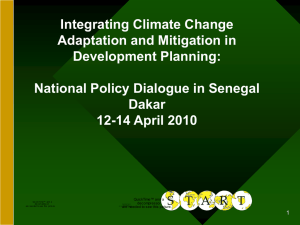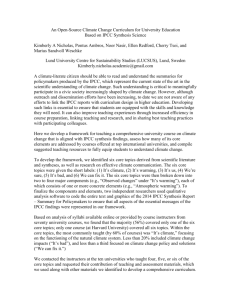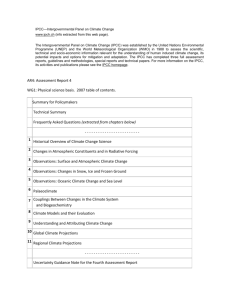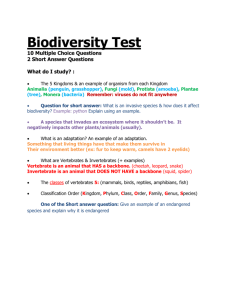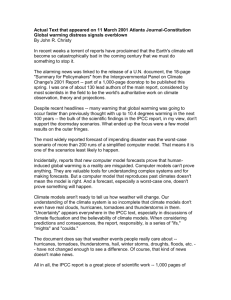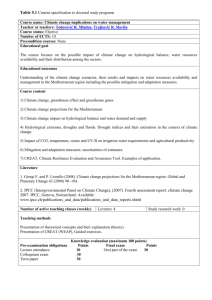Environment – climate change - Capacity4Dev
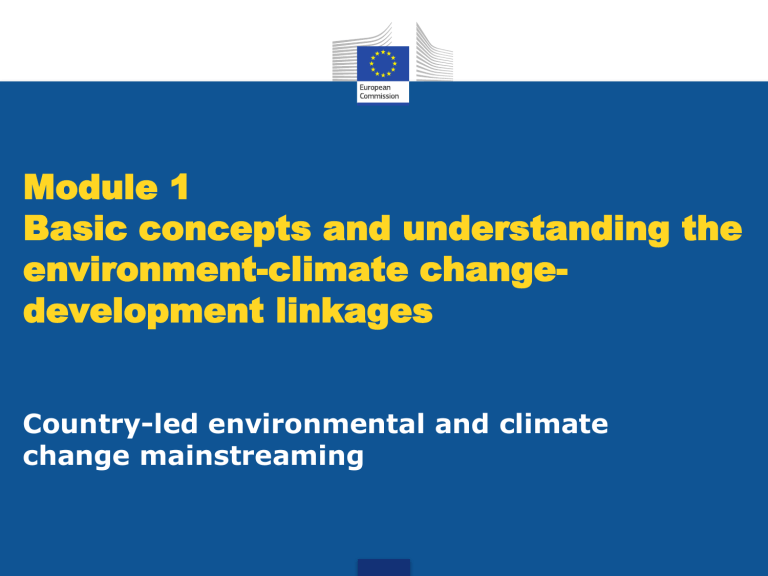
Module 1
Basic concepts and understanding the environment-climate changedevelopment linkages
Country-led environmental and climate change mainstreaming
Are we transgressing “planetary boundaries”?
• The Holocene: Earth’s environment has been stable for the past 10,000 years
• Since the Industrial Revolution, human actions are leading to significant environmental change
• Are we moving into the Anthropocene?
• Could human actions lead to a rupture in the stability the planet has enjoyed for the past 10,000 years?
• Two underlying drivers of change:
• Population: 4x increase in last 100 years, reaching 7 billion
• Economic activity: 20x GDP increase in last 100 years
2
The Holocene
Source: Rockström et al (2009a).
3
Source: Rockström et al,(2009b)
4
• Species becoming extinct 100-1,000x natural rate
• Human processes: conversion of 120 million tN
2
/year, more than effects from all natural processes combined
• About 20 million t P mined/year–8x natural background rate of influx
• Surface ocean pH has decreased about 0.1 units since pre-industrial times – 100x than any other time in the last 20 million years
5
• About 25% of river basins run dry before reaching the oceans due to freshwater use
• Land use change into agricultural land: average rate of 0.8%/yr over the last 40-50 years
• Human activities have doubled global concentration of most aerosols
• More than 140,000 chemical products are commercially available
(UNEP, 2013)
• Toxicity data available only for a few thousand, with virtually no knowledge of combined effects
• CO
2 concentration approx. 400 ppm vs 350 upper safe limit
6
Is climate change real?
• IPCC 5 th Assessment Report:
“ Warming of the climate system is unequivocal, and since the 1950s, many of the observed changes are unprecedented over decades to millennia. The atmosphere and ocean have warmed, the amounts of snow and ice have diminished, sea level has risen, and the concentrations of greenhouse gases have increased ” .
• Observed trends:
- Recent years warmest on record
- Accelerating increase in global surface temperature and ocean temperature
- Accelerating sea level rise
7
Climate Variability vs Climate Change
• Climate variability: shorter-term variations (daily, seasonal, annual, inter-annual, several years)
• Climate change: long-term trends in climate averages (decades or longer)
8
Environment Canada (2012)
Climate change cannot be attributed to natural forcings
Source: IPCC (2013) 5 th Assessment Report, WG I
9
Source: IPCC (2013) 5 th Assessment Report, WG I
10
Observations: intensity of cyclones
Worldwide: %age of Category 1 cyclone (blue curve), sum of Category 2 and 3 (green curve), sum of category 4 and 5 (red curve) on 5 years period. Dashed lines are averages for each category from 1970 to 2004 (Source: Petit & Prudent 2008, p. 42, from Webster et al 2005)
11
The greenhouse effect
Source: WWF/IPCC, http://wwf.panda.org/about_our_earth/aboutcc/how_cc_works/ 12
Global Warming Potential (GWP) and Global
Temperature change Potential (GTP)
Source: IPCC 2013 5AR WGI
Source: Herzog (2005)– WRI
Sources of GHG emissions
14
What are the main consequences?
Biophysical impacts
Socioeconomic impacts
Changes in T °
Changes in rainfall patterns
Shifts in seasons
More frequent or severe storms, floods, droughts
Raised sea level
Erosion, desertification
Changes in water quality/availability
Changes in ecosystems
Biodiversity loss
Disease & pest outbreaks, ...
Damage to or destruction of infrastructure
Reduced food security, malnutrition
Economic disruption, loss of livelihoods, social disruption
Increased mortality and morbidity
Reduced availability of hydropower
Conflicts, population displacement, human migrations, ...
15
Development – Environment links
Mitigation Adaptation
DRR
Human activities
Impacts Opportunities, risks
& constraints
Climate, environment & natural resources
16
Source: Millennium Ecosystem Assessment (2005) Figure B, p. 7.
17
Environment – climate change – development linkages
Climate change:
- an environmental issue
- a development issue
18
Source: Millennium
Ecosystem
Assessment (2005)
Figure B, p. 7.
Risk: The combination of the probability of an event and its negative consequences
Climate
Change
Environmental degradation
Probability
Risk
Hazard
River floods
Pest outbreak
Heatwaves
Sea surge
Landslides
Drought
Mudflows
Earthquakes
Conflict
Consequences
Disaster
19
Exposure
Sensitivity
Vulnerability
“the propensity or predisposition to be adversely affected”
(IPCC, 2012)
World Preservation Foundation, 2010
Adaptive
Capacity
The Times of India, 2012
20
Liz Hempel, 2011
Resilience – Vulnerability - Risk
Resilience
• “Resilience is the ability of an individual, a household, a community, a country or a region to withstand, adapt and to quickly recover from stresses and shocks”
• EU Communication on Resilience (2012)
Rationale for DRR & Resilience
Source: European Commission (2014)
Climate change and environment
• Climate change is a theme to be addressed with other environmental issues:
• Climate change exacerbates certain environmental trends and problems
Credit: Proyecto Rio
Hurtado, EuropeAid Photo
Library
• Environmental management has an impact on climate change
Credit: Vietnamese journalist, EuropeAid Photo
Library
24
Sustainable development and the Green Economy
• Green Economy
An economy that results in improved human well-being and social equity, while significantly reducing environmental risks and ecological scarcities”
(UNEP, 2011)
• It must contribute to SD
• An an operational level:
“An economy whose growth in income and employment is driven by investments that:
• Reduce carbon emissions and pollution;
• Enhance energy and resource efficiency;
• Prevent the loss of biodiversity and ecosystem services”.
(EMG Report, 2011)
25
Which development pathway are we following?
Environment
Sustainable development
Social dimension
Economy
Environment
Social dimension
Economy
For example…
AGRICULTURE
…does it impact on the environment and climate change?...
27
Agriculture
Contributes 13-15% of global carbon emissions
(rising to 30-32% if we include land use change, land degradation and deforestation) (EC, 2012)
Is the main driver behind deforestation
Contributes to pollution of soil, air and water, and loss of biodiversity
Leads to adverse health effects (direct and indirect)
28
AGRICULTURE
…is it affected by environmental degradation and climate change?...
29
Agriculture
Soil erosion and land degradation limit agricultural productivity in many developing countries
Freshwater availability and quality affect crop yields. Climate change is exacerbating these downward trends
Drought intensity and frequency are increasing in various countries due to climate change
Nearly 1 billion people live in chronic hunger, and by 2050 there will be a need to produce to 70% more food globally (EC, 2012)
30
What about health?
In least developed countries, 1/3 of death and disease is a direct result of environmental causes
(WHO, 2010)
Environmental factors influence 85 out of the 102 categories of disease and injury listed in The World
Health Report (WHO)
Climate change that has occurred since the 1970s has caused over 140,000 excess deaths each year, and climate change is estimated to add at least
US$2-4 billion in annual health sector costs (WHO,
2012)
31
Environmental burden of disease
(DALYs/1000 population)
Source: WHO (2006)
DALY = disability-adjusted life year: measure of overall disease burden, expressed as the number of years lost due to ill-health, disability or early death
32
…education?
In 1 out of 3 countries in sub-Saharan Africa with available data, more than half of the schools have no toilet and more than 50% of schools don’t have access to potable water (UNESCO UIS, 2012)
Malaria causes between 4-10 million days of school absenteeism per year (Partnership for Child Development et al, 2009)
In the year 2000 floods in Cambodia, at least 1,000 schools were destroyed and about 500,000 primary and secondary school children affected (ADPC, 2008)
33
Environment, Climate Change and MDGs
Soil erosion, salinisation, land degradation
Eradicate extreme poverty & hunger e.g. Adverse effects on food security e.g. effects on school attendance
Achieving universal primary education
Reduce child mortality
Potential impacts on
MDGs
Polluted water and air… e.g. Increased incidence of waterborne diseases
Scarcity/quality of
NR managed by women
Promote gender equality & empower women e.g. Dependence on livelihoods put at risk by CC
Improve maternal health
Environmental causes of disease
Combat major diseases e.g. Higher incidence of anaemia resulting from malaria e.g. Heat-related mortality & illnesses
Source: OECD (2009a)
Ensure environmental sustainability e.g. Increased stress on ecosystems and biodiversity
34
Positive and negative poverty environment linkages
Win-Lose
Environmental management that excludes local communities (e.g. lack of benefit-sharing, dislocation of communities)
Lose-Lose
Lack of or inadequate environmental management negatively affecting the poor
(e.g. lack of adaptation to climate change, poor environmental health conditions)
Win-Win
Sustainable livelihoods (e.g. sustainable agriculture, forestry, fisheries, ecosystem management, adaptation to climate change)
Lose-Win
Short-term livelihoods (e.g. overgrazing, overfishing, deforestation)
Poverty reduction
Source: UNDP-UNEP (2009), p.8
35
Moving to green, climate-resilient and lowemission development
• Environmental and climate-resilient development and lowemission development result from mainstreaming in policymaking and planning
Environmental mainstreaming
Green development
The three approaches are complementary
Climate change adaptation mainstreaming
Climate-resilient development
In all cases, focus on cobenefits
Mainstreaming of climate change mitigation
Low-emission development
36
Building on Multilateral Environmental
Agreements ’ commitments
• MEAs require elaboration of diagnoses and Action
Plans, e.g.
- Convention on Biological Diversity (CBD); Desertification
(UNCDD); wetlands (Ramsar); POPs (Stockholm
Convention); etc.
• These are a good starting point for addressing the environmental challenge
• They require COORDINATION and
HARMONISATION amongst them and with national and sectoral policy-making and planning processes
37
NAPAs, NAMAs and NAPs
• NAPAs = national adaptation programmes of action
• Help LDCs build national capacities and identify priority adaptation projects with developmental benefits
• NAMAs = nationally appropriate mitigation actions
• Voluntary mitigation measures
• Process launched June, 2013
• NAP = national adaptation plan
• Helpful to identify medium- and long-term adaptation needs and developing/implementing strategies and programmes to address them
• Process launched June, 2013
38
Seizing opportunities
• Green growth
‘ A way to pursue economic growth and development, while preventing environmental degradation, biodiversity loss and unsustainable natural resource use ’ (OECD, 2010b)
• Green jobs
Source: ILO (2013)
39
Developing synergies: green development
- climate change adaptation & mitigation
• Quite frequently measures aimed at green development, adaptation and mitigation reinforce each other
- e.g. reduced tillage agriculture enhances carbon sequestration in soils while supporting soil moisture retention - increasing resilience to dry spells – and reducing soil erosion
- e.g. sustainable reforestation may simultaneously enhance carbon stocks, enhance the adaptive capacity of local communities (by offering new livelihood opportunities), act as protection against soil erosion, enhance water capture, and increase biodiversity 40
• Mitigation should:
• Be compatible with adaptation policies and requirements
• Rely on environmentally sustainable practices
• e.g. unsustainable agrofuels may be a threat to food security, water availability and ecosystems
• Not result in increased vulnerability to climate change
• Adaptation should:
• Consider emissions and environmental impacts, e.g.
• agricultural intensification addressing food security may increase GHG emissions from use of fertilisers and increase water pollution
• increased adoption of air conditioning to adapt to heat waves may result in increased emissions from fossil energy use
• water capture to address drought periods may affect biodiversity, and irrigation systems may lead to soil salinisation
41
Recap – Key messages
• The Earth has enjoyed a stable environment over the past
10,000 years, which is now being compromised due to human action (Holocene Anthropocene)
• Thresholds in key variables are already being exceeded:
- Climate Change
- Loss of biodiversity
- Nitrogen cycle
• Other variable are approaching safe limits, e.g.
- Phosphorous cycle
- Ocean acidification
• For some we still don ’ t have enough data
- Chemical pollution
- Atmospheric aerosol loading
42
Recap – Key messages (2)
• Climate change is real, and is driven to a large extent by emissions of greenhouse gases linked to human activities
- Fossil energy use, deforestation and agriculture are the main culprits
• Climate change is notably characterised by rising temperatures, rising sea level, and more frequent/intense extreme weather events
• Changes in climate system parameters generate a wide range of biophysical and socioeconomic impacts
43
Recap – Key messages (3)
• Environment and climate change are intimately related to development
• development initiatives affect the environment and contribute to climate change
• state of the environmental and climate change affect development
• There is a continuum of responses to address environmental sustainability and climate change, from addressing drivers of vulnerability to specifically confronting impacts
44
Recap – Key messages (4)
• The path to development should be planned so as to be green, climate-resilient and lowemission
• Environmental sustainability, adaptation and mitigation are complementary responses with potential to generate significant ‘ co-benefits ’ in terms of development
45
Key references
• European Commission (2009) Guidance on the Integration of
Environment and Climate Change in Development
Cooperation. EuropeAid Tools and Methods Series, Guidelines
No 4. Available from: http://ec.europa.eu/europeaid/infopoint/
• IPCC website: www.ipcc.ch
• IPCC (2007b) Climate Change 2007: Impacts,
Adaptation and Vulnerability. Cambridge University Press,
Cambridge, UK & New York, NY, USA. Available from: www.ipcc.ch
• IPCC (2007c) Climate Change 2007: Mitigation of Climate
Change. Cambridge University Press, Cambridge, UK & New
York, NY, USA. Available from: www.ipcc.ch
46
Key references (2)
• IPCC (2013) WG I Contribution to the IPCC Fifth
Assessment Report Climate Change 2013: The Physical
Science Basis.
• Millennium Ecosystem Assessment website: www.unep.org/meaweb/en/index.aspx
• UNEP (2012) Global Environment Outlook GEO5,
Environment for the future we want. UNEP.
• UNEP Environmental Data Explorer: http://geodata.grid.unep.ch/
• Volunteer-driven information website ‘ CO
2 http://co2now.org/
Now ’ :
• WWF – Climate change explained: http://wwf.panda.org/about_our_earth/aboutcc/how_cc_w orks/
47
References
• ADPC (2008) A study on impact of disasters on the education sector in Cambodia.
Available from: http://www.adpc.net/v2007/ikm/ONLINE%20DOCUMENTS/downloads/2008/Mar/MDRDEd ucationCambodiaFinal_Mar08.pdf
• Berkeley Earth Surface Temperature Project: http://berkeleyearth.org
• Environment Canada (2012) Climate change concepts. http://www.cccsn.ec.gc.ca/?page=scen-intro Accessed 11/06/2013.
• European Commission (2012) Integration of environment, climate change and the green economy in the agricultural sector. Unpublished draft.
• European Commission (2014) Building effective resilience through risk-informed humanitarian and development programming. Joint ECHO DEVCO workshop, 10
• Herzog T. (2005) World Greenhouse Gas Emissions in 2005. Working paper, World
Resources Institute, Washington, DC. Available from: http://www.wri.org/publication/world-greenhouse-gas-emissions-in-2005
• International Labour Organisation – ILO (2013) Green jobs becoming a reality, Progress and outlook 2013. ILO: Geneva.
• IPCC (2007a) Climate Change 2007: Synthesis Report. Contribution of Working Groups I,
II and II to the Fourth Assessment Report. [Core Writing Team, Pachaury R.K. & Reisinger
A. (eds.)] Intergovernmental Panel on Climate Change, Geneva. Available from: www.ipcc.ch
48
References (2)
• IPCC (2012) Managing the risks of extreme events and disasters to advance climate change adaptation. Special report of the IPCC. Cambridge University Press:
Cambridge.
• McGray H., Hammill A. & Bradley R. (2007) Weathering the Storm: Options for
Framing Adaptation and Development. World Resources Institute, Washington, DC.
Available from: http://pdf.wri.org/weathering_the_storm.pdf
• Millennium Ecosystem Assessment (2005) Ecosystems and Human Well-being:
Synthesis. Island Press, Washington, DC. Available from: http://www.maweb.org/en/Synthesis.aspx
• OECD (2009a) Integrating Climate Change Adaptation into Development Co-operation:
Policy guidance. OECD Publishing, Paris. [Read-only, browse-it edition] Available from: http://browse.oecdbookshop.org/oecd/pdfs/browseit/4309171E.PDF
• OECD (2010b) Interim Report of the Green Growth Strategy: Implementing our commitment for a sustainable future. Meeting of the OECD Council at Ministerial Level,
27-28 May 2010. C/MIN(2010)5. Organisation for Economic Cooperation and
Development, Paris. Available from: http://www.oecd.org/document/3/0,3343,en_2649_37465_45196035_1_1_1_1,00.ht
ml
49
References (1)
References (3)
• Partnership for Child Development; London School of Hygiene and Tropical Medicine;
Kenya Medical Research Institute-Wellcome Trust Research Programme and The
World Bank (2009). Malaria Control in Schools, a toolkit on effective education sector responses to malaria in Africa. Available from: http://www.schoolsandhealth.org/Documents/Malaria%20Toolkit%20for%20Schools
%202009.pdf
• Petit J. & Prudent G. (eds) (2008, reprint 2010) Climate Change and Biodiversity in the European Union Overseas Entities. IUCN, Gland, Switzerland and Brussels,
Belgium. Available from: http://data.iucn.org/dbtw-wpd/edocs/2010-064.pdf
• Rockström et al (2009a) A safe operating space for humanity. Nature, Vol 461, 24
September, 2009.
• Rockström et al (2009b) Planetary Boundaries: exploring the safe operating space for humanity. Ecology and Society, 14(2):32.
• UNDP-UNEP (2009) Mainstreaming Poverty-Environment Linkages into Development
Planning: A Handbook for Practitioners. UNDP-UNEP Poverty-Environment Initiative.
• UNEP (2011) Towards a green economy: pathways to sustainable development and poverty eradication. UNEP: Nairobi.
• UNEP (2013) GCO Global Chemical Outlook. Towards sound management of chemicals. UNEP.
50
References (4)
• UNESCO UIS (2012) School and teaching resoures in sub-Saharan Africa, Analysis of the 2011 UIS regional data collection on education. Available from: http://www.uis.unesco.org/FactSheets/Documents/ib9-regional-education-africa-
2012-en-v5.pdf
• WHO (2006) Preventing disease through healthy environments, Towards and estimate of the environmental burden of disease. Prepared by Prüss-Üstün, A and Corvalán, C,
WHO: Geneva.
• WHO (2010) WHO Fact File: 10 facts on preventing disease through healthy environments. Available from: http://www.who.int/features/factfiles/environmental_health/en/index.html
• WHO (2012) WHO Fact File: Climate change and health. Available from: http://www.who.int/mediacentre/factsheets/fs266/en/
• WWF – Climate change explained: http://wwf.panda.org/about_our_earth/aboutcc/how_cc_works/
51


